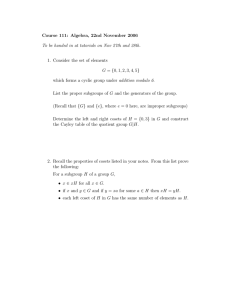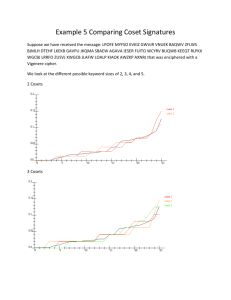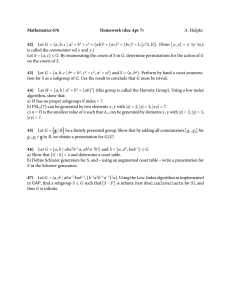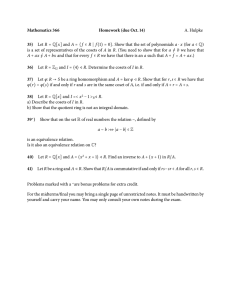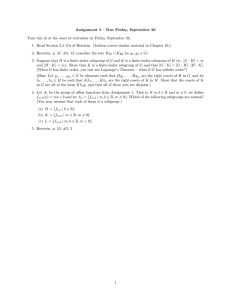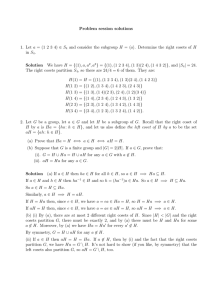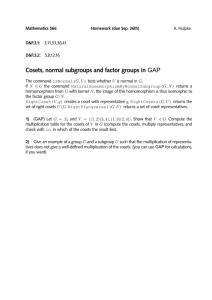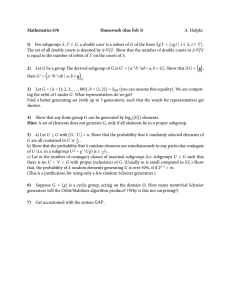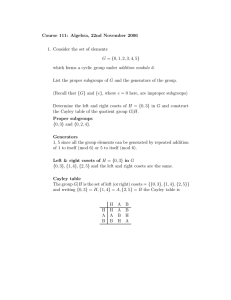Solutions for Assignment 3 | h ∈ H} (Hg)
advertisement
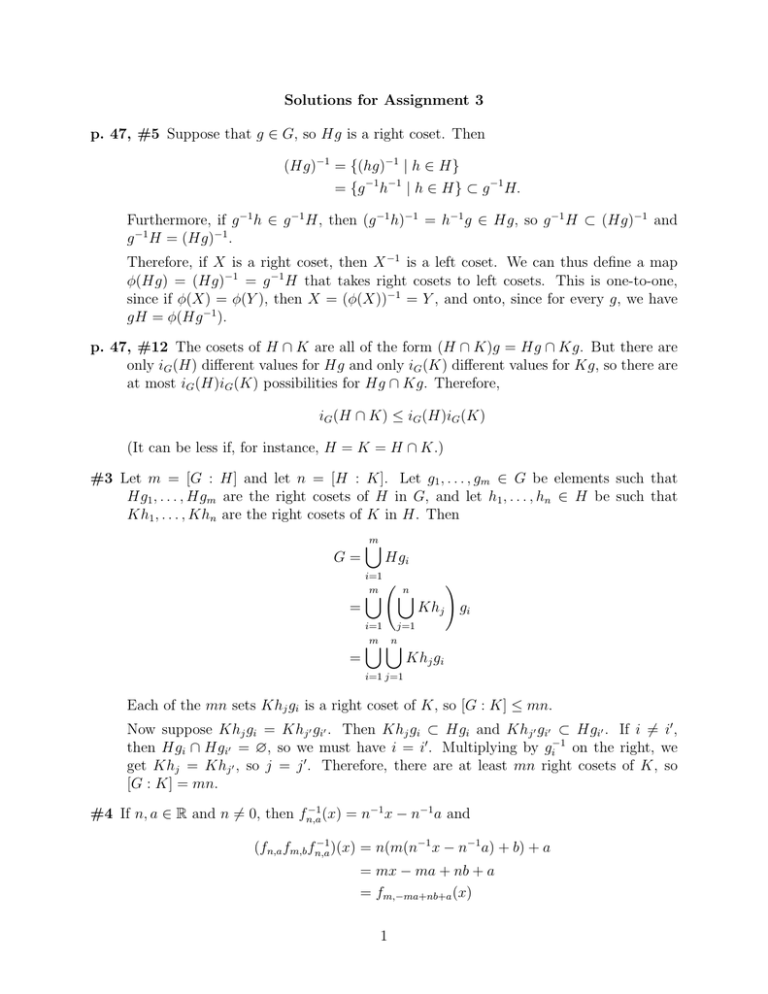
Solutions for Assignment 3
p. 47, #5 Suppose that g ∈ G, so Hg is a right coset. Then
(Hg)−1 = {(hg)−1 | h ∈ H}
= {g −1 h−1 | h ∈ H} ⊂ g −1 H.
Furthermore, if g −1 h ∈ g −1 H, then (g −1 h)−1 = h−1 g ∈ Hg, so g −1 H ⊂ (Hg)−1 and
g −1 H = (Hg)−1 .
Therefore, if X is a right coset, then X −1 is a left coset. We can thus define a map
φ(Hg) = (Hg)−1 = g −1 H that takes right cosets to left cosets. This is one-to-one,
since if φ(X) = φ(Y ), then X = (φ(X))−1 = Y , and onto, since for every g, we have
gH = φ(Hg −1 ).
p. 47, #12 The cosets of H ∩ K are all of the form (H ∩ K)g = Hg ∩ Kg. But there are
only iG (H) different values for Hg and only iG (K) different values for Kg, so there are
at most iG (H)iG (K) possibilities for Hg ∩ Kg. Therefore,
iG (H ∩ K) ≤ iG (H)iG (K)
(It can be less if, for instance, H = K = H ∩ K.)
#3 Let m = [G : H] and let n = [H : K]. Let g1 , . . . , gm ∈ G be elements such that
Hg1 , . . . , Hgm are the right cosets of H in G, and let h1 , . . . , hn ∈ H be such that
Kh1 , . . . , Khn are the right cosets of K in H. Then
G=
=
=
m
[
Hgi
i=1
m
[
n
[
!
Khj
gi
i=1 j=1
m [
n
[
Khj gi
i=1 j=1
Each of the mn sets Khj gi is a right coset of K, so [G : K] ≤ mn.
Now suppose Khj gi = Khj 0 gi0 . Then Khj gi ⊂ Hgi and Khj 0 gi0 ⊂ Hgi0 . If i 6= i0 ,
then Hgi ∩ Hgi0 = ∅, so we must have i = i0 . Multiplying by gi−1 on the right, we
get Khj = Khj 0 , so j = j 0 . Therefore, there are at least mn right cosets of K, so
[G : K] = mn.
−1
#4 If n, a ∈ R and n 6= 0, then fn,a
(x) = n−1 x − n−1 a and
−1
(fn,a fm,b fn,a
)(x) = n(m(n−1 x − n−1 a) + b) + a
= mx − ma + nb + a
= fm,−ma+nb+a (x)
1
1. For any f1,b ∈ H and any n, a ∈ R, n 6= 0, we have
−1
fn,a f1,b fn,a
= f1,nb ∈ H,
so H is normal.
2. For any fm,0 ∈ K and any n, a ∈ R, n 6= 0, we have
−1
fn,a fm,0 fn,a
= fm,−ma+a .
If m 6= 1 and a 6= 0, this is not in K, so K is not normal.
3. For any fm,b ∈ L and any n, a ∈ R, n 6= 0, we have
−1
fn,a fm,b fn,a
= fm,−ma+nb+a ∈ L,
so L is normal.
p. 53, #2 If [G : H] = 2, then the right cosets of H are H and H c (the complement of H),
and the left cosets of H are also H and H c . So every left coset is a right coset, and H
is normal.
p. 53, #3 By Lemma 2.5.1 of Herstein, HN is a subgroup if and only if HN = N H. We
have
HN = {hn | h ∈ H, n ∈ N }
[
hN.
=
h∈H
Since N is normal, hN = N h for all h, and HN =
is a subgroup.
2
S
h∈H
N h = N H. Therefore, HN
